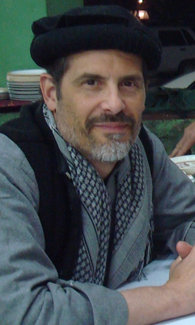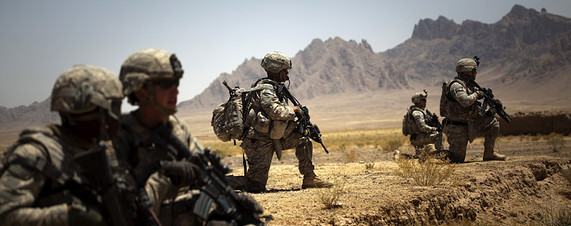Related articles:
– Top US commander in Afghanistan: The Taliban have gained the upper hand:
The Taliban have gained the upper hand in Afghanistan, the top American commander there said, forcing the U.S. to change its strategy in the eight-year-old conflict by increasing the number of troops in heavily populated areas like the volatile southern city of Kandahar, the insurgency’s spiritual home. Gen. Stanley McChrystal warned that means U.S. casualties, already running at record levels, will remain high for months to come.
(Source: The Wall Street Journal)
– General Sir David Richards: Afghanistan will take 30 to 40 years
– Former SAS Comander: Afghan operation is ‘worthless’

McClatchy’s Jonathan S. Landay earlier this year in Pakistan.
GANJGAL, Afghanistan — We walked into a trap, a killing zone of relentless gunfire and rocket barrages from Afghan insurgents hidden in the mountainsides and in a fortress-like village where women and children were replenishing their ammunition.
“We will do to you what we did to the Russians,” the insurgent’s leader boasted over the radio, referring to the failure of Soviet troops to capture Ganjgal during the 1979-89 Soviet occupation.
Dashing from boulder to boulder, diving into trenches and ducking behind stone walls as the insurgents maneuvered to outflank us, we waited more than an hour for U.S. helicopters to arrive, despite earlier assurances that air cover would be five minutes away.
U.S. commanders, citing new rules to avoid civilian casualties, rejected repeated calls to unleash artillery rounds at attackers dug into the slopes and tree lines — despite being told repeatedly that they weren’t near the village.
“We are pinned down. We are running low on ammo. We have no air. We’ve lost today,” Marine Maj. Kevin Williams, 37, said through his translator to his Afghan counterpart, responding to the latter’s repeated demands for helicopters.
Four U.S. Marines were killed Tuesday, the most U.S. service members assigned as trainers to the Afghan National Army to be lost in a single incident since the 2001 U.S.-led invasion. Eight Afghan troops and police and the Marine commander’s Afghan interpreter also died in the ambush and the subsequent battle that raged from dawn until 2 p.m. around this remote hamlet in eastern Kunar province, close to the Pakistan border.
Three Americans and 19 Afghans were wounded, and U.S. forces later recovered the bodies of two insurgents, although they believe more were killed.
The Marines were cut down as they sought cover in a trench at the base of the village’s first layer cake-style stone house. Much of their ammunition was gone. One Marine was bending over a second, tending his wounds, when both were killed, said Marine Cpl. Dakota Meyer, 21, of Greensburg, Ky., who retrieved their bodies.
HISTORY OF RESISTANCE
A full moon was drenching the mountains in ghostly light as some 60 Afghan soldiers, 20 border police officers, 13 Marine and U.S. Army trainers and I set out for Ganjgal at 3 a.m. from the U.S. base in the Shakani District.
The operation, proposed by the Afghan army and refined by the U.S. trainers, called for the Afghans to search Ganjgal for weapons and hold a meeting with the elders to discuss the establishment of police patrols. The elders had insisted that Afghans perform the sweep. The Americans were there to give advice and call for air and artillery support if required.
Dawn was breaking by the time we alighted for a mile-long walk up a wash of gravel, rock and boulders which winds up to Ganjgal, some 60 rock-walled compounds perched high up the terraced slopes at the eastern end of the valley, six miles from the Pakistani border.
Small teams of Afghan troops and U.S. trainers headed to ridges on the valley’s southern and northern sides, setting up outposts as the main body headed slowly up toward the village and, unbeknownst to us, into the killing zone.
The terrain — craggy ravines and sweeping, tree-studded mountains riddled with boulders and caves — was made for guerrilla warfare. The ethnic Pashtun villagers pride themselves on their rejection of official authority, their history of resistance and their disdain of foreign forces that many regard as occupiers.
A possible clue to what was to come occurred when the lights in Ganjgal suddenly blinked out while our vehicles were still several miles away, crashing slowly through the semi-dark along a rutted track toward the village.
NO AIR SUPPORT
The first shot cracked out at 5:30 a.m., apparently just as the four Marines and the Afghan unit to which they were attached reached the outskirts of the village. It quickly swelled into a furious storm of gunfire that we realized had been prepared for our arrival.
Several U.S. officers said they suspected that the insurgents had been tipped off by sympathizers in the local Afghan security forces or by the village elders, who announced over the weekend that they were accepting the authority of the local government.
“Whatever we do always leaks,” said Marine Lt. Ademola Fabayo, 28, a New Yorker who was born in Nigeria and is the operations officer for the trainers from the 3rd Marine Division. “You can’t trust even some of their soldiers or officers.”
Sniper rounds snapped off rocks and sizzled overhead. Explosions of recoilless rifle rounds echoed through the valley, while bullets inched closer to the rock wall behind which I crouched with a handful U.S. and Afghan officers.
Lt. Fabayo and several other soldiers later said they’d seen women and children in the village shuttling ammunition to fighters positioned in windows and roofs. Across the valley and from their ridgeline outposts, the Afghans and Americans fired back.
At 5:50 a.m., Army Capt. Will Swenson, of Seattle, WA, the trainer of the Afghan Border Police unit in Shakani, began calling for air support or artillery fire from a unit of the Army’s 10th Mountain Division. The responses came back: No helicopters were available.
“This is unbelievable. We have a platoon (of Afghan army) out there and we’ve got no Hotel Echo,” Swenson shouted above the din of gunfire, using the military acronym for high explosive artillery shells. “We’re pinned down.”
The insurgents were firing from inside the village and from positions in the hills immediately behind it and to either side. Judging from the angles of the ricochets, several appeared to be trying to outflank us to get better shots.
“What are you going to do?” Maj. Talib, the operations officer of the Afghan army unit, asked Maj. Williams through his translator.
“We are getting air,” Williams replied.
“What are we going to do?” Talib repeated.
“We are getting air,” Williams replied again, perhaps knowing that none was available but hoping to quiet Talib.
At 6:05 a.m., as our position was becoming increasingly tenuous, Swenson and Fabayo agreed that it was time to pull back and radioed for artillery to fire smoke rounds to mask our retreat.
“They don’t have any smoke. They only have Willy Pete,” Swenson reported, referring to white phosphorus rounds that spew smoke.
Fifty minutes later, as a curtain of white phosphorus smoke roiled across the valley, Swenson and Fabayo unleashed an intense volley of covering fire while the rest of us sprinted back some 20 yards to a series of dirt furrows, weighed down by our flak vests and water carriers.
The two officers raced back to join us. Everyone jumped up and ran for the next stone wall. Everyone but me. Afraid that too many people were jammed together as they raced, offering easy targets, I waited behind for a break in the gunfire, an Afghan border police officer crouched next to me.
TIME TO MOVE
We soon noticed that the insurgent snipers were trying to outflank us again. I saw one up on a small rise fire and miss us by several feet. My companion decided that it was time to go and bolted away across the wash, but the gunfire grew too intense, and again I pulled my body into the dirt and rocks.
I wasn’t as terrified as I was angry: angry at the absence of air support, angry that there was no artillery fire, angry that Williams’ interpreter had been killed, angry at the realization that the operation had obviously been betrayed and angry at myself for not bolting with the others.
I knew it was time to move when I saw a gaggle of Afghan soldiers pounding through the boulders past me, their commander, a bright 26-year-old lieutenant named Ruhollah, hopping between two of them, a bullet wound in his groin. Staying put was no longer an option.
Bundling my legs beneath me and grabbing the small bag I use to carry my pad, pens, glasses and other necessities, I sprang and ran, trying to weave as bullets kicked up dust around me.
I reached the next wall and plunged behind it, nearly falling on top of Swenson, Fabayo and several badly wounded U.S. soldiers.
As Fabayo cracked off rounds, Swenson lay flat on his back, clasping a pressure bandage to the shoulder of one soldier with one hand and holding the microphone of his radio in the other, calling out insurgents’ positions to two U.S. helicopters that finally had arrived.
It was now 7:10 a.m., and with the helicopters prowling overhead and firing into the hillsides, the incoming gunfire slackened enough for us to move again.
I stumbled down the valley to safety after I helped one of the injured soldiers into a medivac helicopter. Capt. Swenson and Lt. Fabayo headed off to find vehicles and, together with Cpl. Meyer, crashed back up the way we’d just fled to retrieve the bodies of the dead Marines and any other casualties they could find.
ABOUT THE REPORTER
McClatchy’s Jonathan S. Landay, who was ambushed with U.S. Marines in a remote Afghan village Tuesday, is a veteran foreign affairs reporter with long experience in South Asia, Iraq, the Balkans and Washington.
Landay covered South Asia — including Afghanistan — as well as the Balkans from 1985 to 1994 for United Press International and for The Christian Science Monitor. He joined the Knight Ridder Washington Bureau in 1999.
He was part of the Knight Ridder team, with State Department correspondent Warren P. Strobel and Bureau Chief John Walcott, that investigated and disproved the Bush administration’s claims that Saddam Hussein’s Iraq had an active nuclear weapons program and ties to al Qaida.
The team won a National Headliner Award for “How the Bush Administration Went to War in Iraq,” a 2005 Award of Distinction from Northwestern University’s Medill School of Journalism for “Iraqi Exiles Fed Exaggerated Tips to News Media,” and a 2007 Edward Weintal Prize from Georgetown University’s Institute for the Study of Diplomacy for the Iraq coverage.
The McClatchy Co. acquired Knight Ridder in 2006, and Landay is now the senior national security correspondent in the McClatchy Washington Bureau and a regular contributor to the bureau’s Nukes & Spooks blog. He regularly travels to Afghanistan, Pakistan and other trouble spots.
Jonathan S. Landay – McClatchy Newspapers
Published: Tue, Sep. 08, 2009 07:38PM Modified Wed, Sep. 09, 2009 05:46PM
Source: McClatchy
